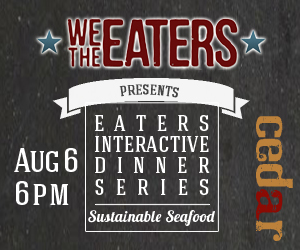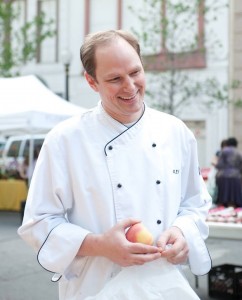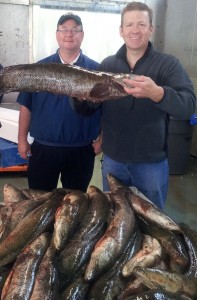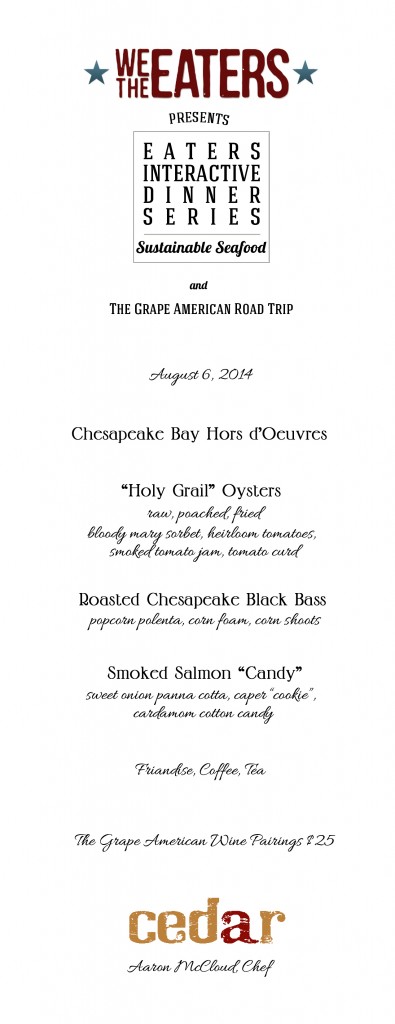Today we’re talking with Aaron McCloud, executive chef of Cedar Restaurant in Washington, D.C. , and the sustainable director of seafood purveyor ProFish, Ltd., John Rorapaugh.
ProFish has established a long track record in its commitment to sustainably sourcing the products they sell, and Cedar is known for using sustainable, local and seasonal ingredients — so local that Fodor’s Travel recently named it one of the top 10 Roof-to-Table Restaurants in America. Our cover photo features Chef McCloud shopping at Black Rock Orchard in Penn Quarter’s farmer’s market, part of FRESHFARM Markets, a local non-profit. According to the organization’s website, their mission is to, “build and strengthen the local, sustainable food movement in the Chesapeake Bay watershed.”
Both Aaron and John are partnering with We The Eaters for our first live event on August 6th. They share a similar passion for sustainability, particularly when it comes to seafood.
SUSTAINABILITY AND BUSINESS
 AMY: Why is sustainability important?
AMY: Why is sustainability important?
AARON: Sustainability is important for several reasons regarding seafood, as well as other products we eat as consumers and restaurants buy and prepare. The very nature of the word suggests the most important part: We need to keep our Earth a sustainable place for us and the other species with which we share it — a viable, sustainable place. This is a big responsibility.
As a restaurant professional and the one who purchases and designs the final product, I feel that it’s a personal responsibility.
JOHN: And as a business, you want to support a system that promotes the longevity of your industry. As a fisherman, Washingtonian, and environmentalist, I want healthy local fish populations for generations to come.
AARON: That’s right. As a business, we need to be leaders within the local, national and world community for this cause. This is one of the reasons we at Cedar feel it’s great to be partnered with ProFish.
AMY: John, can you tell us about your preservation efforts at ProFish?
 JOHN: We offer sustainable options for every customer. Our coolers are stocked with a majority of USA sustainably managed fish. Unlike the country average of 80 percent consumed seafood being imported, our supply chain consists of 80 percent domestic!
JOHN: We offer sustainable options for every customer. Our coolers are stocked with a majority of USA sustainably managed fish. Unlike the country average of 80 percent consumed seafood being imported, our supply chain consists of 80 percent domestic!
AMY: And what about at Cedar, Aaron?
AARON: The Chesapeake region is greatly affected by the drive toward seafood sustainability and care for the Chesapeake Bay. The ecology, as well as our regional economy, are affected daily by the health of these waters and the species within. Our oyster population alone drives millions of dollars in our area and can help keep the waters clean. One oyster can filter 50 gallons of water per day! This fact is indicative of the type of issue restaurants need to be mindful [of], and be dedicated to the sustainable fishing practices many of our watermen have practiced for generations.
At Cedar, we do our very best to serve products only in season and know where they’re coming from. We work with dedicated fish purveyors, local produce and livestock farms, and national and international producers of livestock dedicated to humane raising practices.
WHERE THE CONSUMER COMES IN
AMY: How does a consumer know they are getting a sustainable product?
AARON: Know your product. Know the restaurant’s chef. Try to read up on the topic. Don’t be thrown off by goofy ads that use buzz words.
JOHN: The easiest way is to buy seafood that is harvested in the U.S. and sustainably managed by the National Oceanic and Atmospheric Administration.
AMY: So when a consumer is shopping for the best place for fresh, sustainable seafood … what should they be looking for?
JOHN: Most importantly: seafood from domestic managed fisheries! Buying local is always the best policy when looking for fresh, sustainable seafood. Purchase whole fish if you have the fillet skills. If not, pick out a whole fish with red gills and firm flesh and have [the fishmonger] fillet it for you.
skills. If not, pick out a whole fish with red gills and firm flesh and have [the fishmonger] fillet it for you.
The two best friends you have with fish inspection are your eyes and nose. Smell the belly and gills, then press firmly on the flesh. It should immediately spring back and not leave fingerprints.
AARON: I agree completely with John on this one. Also, know what the labels actually mean. This goes for all foods. Unfortunately, the word “organic” can be legally used for things that really are far from what the idea is all about. But really, know a local market where you have a relationship with the people selling the product and you know where it’s actually coming from.
AMY: John, what are five questions a consumer should ask when selecting seafood?
JOHN:
- Where is it from?
- When was it received?
- How was it caught?
- Is it farm raised or wild?
- If it was farm raised, are any sustainable certifications attached to it?
More important than the actual answers is if the fishmonger can answer them knowledgeably.
COOKING FISH AT HOME
AMY: That just leaves us with one question — this one’s for Aaron. Once we get it home … what do we do with it? We The Eaters has been exploring this all month — from cooking fish in a rice cooker or poaching it in the dishwasher, to salt encrusted whole fish — but what are your tips?
AARON: There are usually several methods to cook different fish. Fattier fish usually offer the most options. For example, a great piece of sablefish can be poached in stock or a nage or oil, grilled, confited, smoked, cured, sautéed, fried, baked, etc, etc, etc. However, a lighter fish, like fluke, limits our options. For this sort of fish, I might do a simple crust and sear, or roast it with some shellfish and vegetables, or simply slice it and eat it raw.
The point is, there are a million-and-one ways to cook fish. Experimentation is the key! The home cook doesn’t have the advantage of doing it all day, every day. However, I always like to suggest to home cooks to experiment and not think there is a “right or wrong.” Read some cook books and experiment. We chef guys can help you get some ideas. After that, it’s your kitchen so, have fun and eat well.
AMY: Thanks to both of our guests. And for all our Eaters out there … we hope you’ll join us for the event with these pros on August 6! See the sneak peek of the menu at right!



Great information! I love fish and it pretty much goes with everything. – Melanie